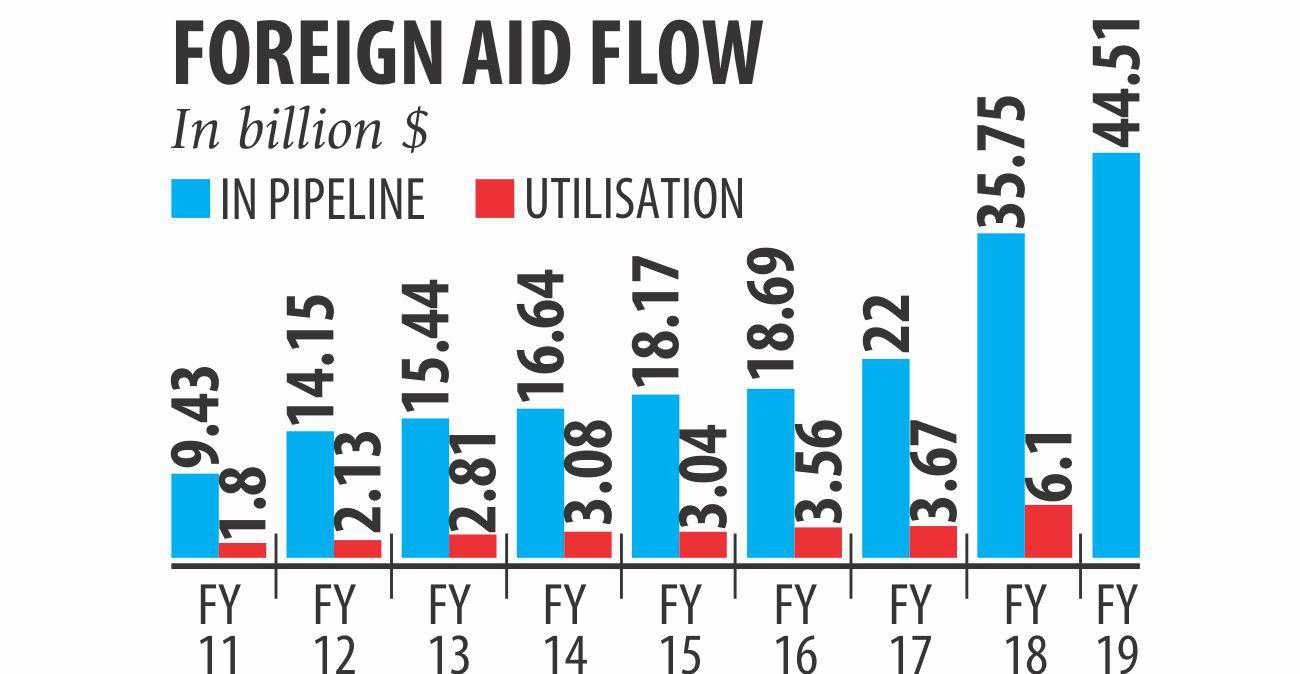Foreign aid in pipeline: $44b
09 July, 2018

Unused foreign aid has reached a new high of $44.51 billion despite a record disbursement of development assistance in the last fiscal year, data from the Economic Relations Division showed.
The ERD officials said the amount of the unused foreign aid piled up thanks to the commitment of a huge amount of funds as well as slow pace of implementation of projects affected by faulty design, lengthy approval process and complexity in land acquisition.
According to the ERD data, the foreign aid in the pipeline was $35.75 billion on June 30, 2017 and rose 24.50 percent to $44.51 billion a year later. ERD Secretary Kazi Shofiqul Azam told The Daily Star, “Foreign aid has to be in the pipeline. Otherwise how can we spend it?”
The ministries and divisions could utilise a record amount of foreign aid of $6.1 billion in the just concluded fiscal year. The government has targeted to disburse $7.5 billion in 2018-19.
“It is not possible to expedite the utilisation of foreign aid beyond this,” Azam said.
According to the ERD data, the government utilised $3 billion to $3.6 billion in foreign aid per year in the four years from 2012-13 to 2016-17.
Aid utilisation almost doubled in the last fiscal year from $3.56 billion in 2016-17.Azam said the government has received billions of dollars in aid commitments from Russia, China and India, which significantly raised the amount of external funds in the pipeline.
Russia committed $11.38 billion for the Rooppur nuclear power plant project. Of the funds, $1 billion was spent in 2017-18 and the rest will be spent by 2023-24, the year when the plant is supposed to be fully implemented.
Before 2009-10, Bangladesh used to receive aid commitment of $1 billion to $2 billion every year. It jumped up to $5 billion from 2009-10. The government received the highest $7 billion aid commitment until 2015-16.
The record broke in 2016-17 when the commitment made reached $17.96 billion, which included the fund for the Rooppur nuclear power plant project.
In the last fiscal year, the country received a commitment of $14.86 billion, with China and India accounting for $4.35 billion and $4.5 billion respectively.
In practice, when a loan agreement is signed with a development partner it is considered commitment, meaning the fund is ready for utilisation and the unused portion of a fund is added to the pipeline.
For instance, during his visit to Bangladesh in 2016 Chinese President Xi Jinping promised $21.5 billion in soft loans for the country. But, since no loan agreement was signed at the time, the sum did not enter the log for foreign aid commitment made during the year.
The loan agreements for five projects involving $4.35 billion were struck with the Chinese Exim Bank in 2017-18. The bank has already disbursed about $1 billion, ERD officials said.
Since 2010, India also committed $7.5 billion under three lines of credit. But only $607 million has been used so far.
The reason for the low utilisation includes complexities in the projects rather than the neighbouring country dragging its feet in parting with the amount, said an ERD official.
Much time is consumed in the approval process in both countries, he said.
Japan, World Bank, and Asian Development Bank have also committed huge amount of funds in recent years.
Japan committed billions of dollars for mega such as the Dhaka Metro Rail project and the Matarbari coal-fired power plant, but their implementation came almost to a halt after seven Japanese nationals were killed in the 2016 Holey Artisan Bakery attack. The deceased Japanese nationals included experts for the metro rail project.
However, the ERD official said the implementation expedited from last fiscal year. According to the ERD's “Flow of external resource into Bangladesh” report published last year, the sluggish implementation of project results in slow disbursement of aid, leading to time and cost overruns.
The report said projects are often designed without proper planning or feasibility studies and people engaged in project preparation are not properly trained.
Delay in approval of awarding contracts, appointing consultants, releasing funds as well as the lack of coordination among financiers in case of multi-donor funded projects were found to be the causes for the slow disbursement, according to the ERD report.
